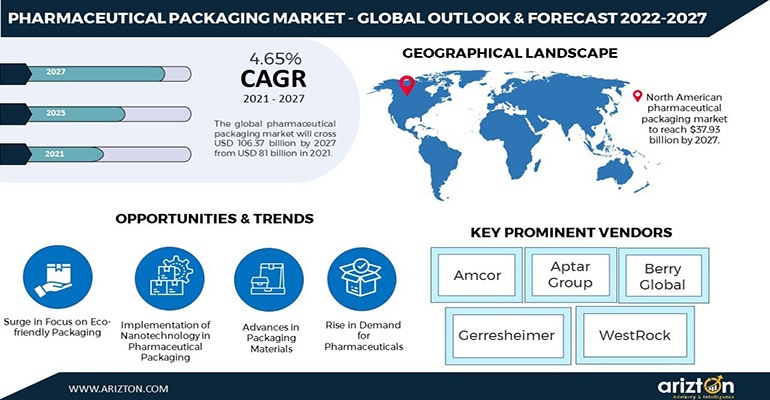Pharmaceutical Packaging Market to Top $106 Billion by 2027
Pharma innovations ranging from unconventional medication administration to smart packaging will contribute to a 4.65% growth rate.
January 19, 2023

The global pharmaceutical packaging market is poised for a CAGR of 4.65% through 2027, according to a new report from Chicago-based Arizton. The company places the market value at $81 billion in 2021 and forecasts value of $106.37 billion in 2027.
The report covers plastic, glass, paper, and other materials used to manufacture primary, secondary, and tertiary pharmaceutical packaging. Blister packs, bottles, vials, and ampoules are included in the coverage of primary packaging.
Arizton’s research shows that growth drivers for pharmaceutical packaging include increasing demand for drug-delivery devices, such as self-administered devices; innovative packaging options; and nontraditional routes of administration for medication, including transdermal, nasal, rectal, intravenous, and biologics.
An increased preference for unit-dose pharmaceutical packaging is also driving market growth. These formats include blister packs, which require fewer resources to manufacture than alternative package formats, are compact and less expensive than bottles and bags, and offer good shelf life, product visibility, and easy handling.
Advances in sustainable packaging in particular and in packaging materials in general are surging.
Smart measures that counter drug counterfeiting.
Expanding sales of over-the-counter drugs are fueling market growth, particularly done via the internet. The growth in online OTC drug sales is related to an uptick in drug counterfeiting worldwide, which is in turn spurs development of anti-counterfeit packaging for OTC and prescription pharmaceuticals.
Arizton predicts the pharmaceutical industry will see increased adoption of nanotech packaging solutions to fight counterfeiting and help pharmaceutical companies and prevent distribution outside their intended markets.
Additional nanotech deployments will include antimicrobial pharmaceutical packaging and the use of expanded polystyrene (EPS) “peanuts” to produce nanoparticles for lithium-battery anodes.
Smart packaging also will play an important role in global pharmaceutical packaging, with recent regulations requiring pharmaceutical-packaging digitalization to assure product authenticity.
Technologies in this realm include serialization, bar coding, and holograms to overcome medication errors, boost sustainability, improve manufacturing efficacy, and address child-safety challenges.
The report additionally covers pharmaceutical vendors’ activities, including global distribution expansion and large-scale investments in the pharmaceutical packaging market. Major vendors singled out in the report include Amcor, Aptar Group, Berry Global, Specialty Polyfilms, Drug Plastics Group, and Super Olefins.
You May Also Like


